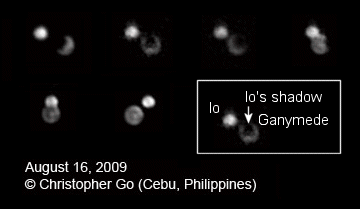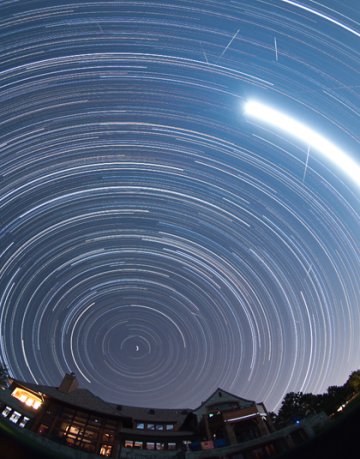| SOLAR ACTIVITY: Today in England, Les Cowley looked at the minimum sun with little hope of seeing anything interesting. "I was very pleasantly surprised to find an impressive prominence," he says. Readers with solar telescopes, point your optics at the northwestern limb of the sun. JUPITER MOON MOVIE: Four hundred years ago when Galileo discovered the moons of Jupiter, the satellites appeared in his primitive telescope as tiny, almost infinitesimal specks of light pirouetting around the giant planet. Their discovery transformed 17th century cosmology and made Galileo famous, but he never saw them as anything more than star-like pinpricks. The "Galilean satellites" were second-class citizens in the heirarchy of known worlds. What would Galileo say now? On August 16th, Philippine astrophotographer Christopher Go used a modern 11-inch Celestron telescope to photograph Io casting its shadow on Ganymede. Click on the image to launch the movie: 
"I captured this rare event through a hole in the clouds," says Go. "It was a lucky clearing!" In the movie, Io and Ganymede reveal themselves as fully-formed worlds with surface markings and a spherical shape. Io's circular shadow cuts a dark swath across Ganymede, transforming that giant moon (it is larger than Mercury) into a succession of crescents rarely seen by observers. Indeed, as far as we know, no telescope on Earth or space has ever photographed one of Jupiter's moons casting its circular shadow so clearly across another. "While imaging the shadow transit, I took the time to photograph Jupiter itself," says Go. "The Great Red Spot, an anticyclone twice the size of Earth, was very prominent." At this point, one imagines Galileo would jump up and exclaim--"bring me a telescope!" If only we could. August 2009 is a superb time to watch the giant planet. Jupiter is at its closest to Earth and outshines every star in the night sky. Backyard optics reveal giant storms, clouds, moons, moon shadows and occasionally an explosive surprise. The place to look is here. UNRULY STAR TRAILS: When a photographer points his camera at the North Celestial Pole and opens the shutter, stars are supposed to make long, graceful arcs around Polaris. They're called "star trails." On August 11th, some of the stars did not cooperate: 
That's because they were shooting stars. "I took the picture during the Perseid meteor shower," says Tom Warner of Rapid City, South Dakota. "It is an all-night composite of 20-second exposures from my Nikon D700. The bright Moon is visible along with some of the brighter Perseids cutting across the star trails." Browse the gallery for updated images of the best Perseid shower since 1993: 2009 Perseid Photo Gallery
[Science@NASA: The Perseids are Coming, Horse Flies and Meteors]
2009 Noctilucent Photo Gallery
[previous years: 2008, 2007, 2006, 2005, 2004, 2003]
Explore the Sunspot Cycle | 
